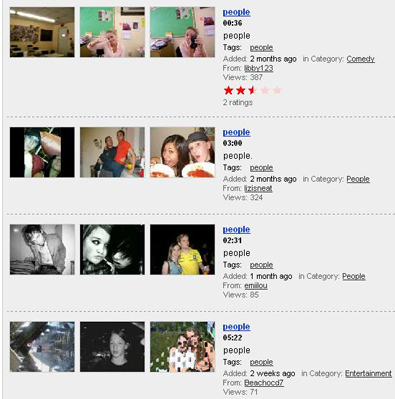YouTube: the world's on-demand reality show

While touting its growth in video serving yesterday, YouTube described the more than 100 million videos a day its viewers watch as “snack-sized” video fare:
The site specializes in short—typically 2-minute—homemade, comic videos created by users. YouTube serves as a quick entertainment break.
While Andy Warhol famously said "In the future everyone will be world-famous for 15 minutes," YouTube’s video stars are apparently encouraged to seek about five minutes of broadcast fame (five minutes which could be replayed endlessly, of course).
In addition to shorter attention spans than in Any Warhol’s day, current technology constraints impact YouTube’s “snack-sized” content. According to YouTube:
How long can my video be?
Most videos on YouTube are under five minutes long. There is no specific length limit, but longer videos require more compression to fit in the 100MB size limit, and the quality will go down as the length of the video goes up.
How long will my video take to upload?
Depending on your connection speed and the size of the video, it can take anywhere from a few minutes to several hours to upload a video. Generally, if you have a high-speed internet connection you can expect the upload to take somewhere between 1-5mins for every 1MB. However, the experience is different for every user because of the variation in connection speeds.
Is there a limit to how much I can upload?
Currently, the only limit is 100MB and 10 minutes in length per video (there is no length limit for Director accounts). We don't have any limit for the number of videos you can upload, and don't foresee adding a ceiling anytime in the future.
Virginia Tech Magazine, in a Spring 2004 issue, traced the history of reality shows from their radio beginnings in 1947:
The first reality program aired in 1947, when Allen Funt's "Candid Microphone" broadcast the complaints of servicemen on Armed Forces Radio. The following year, Funt applied his idea to the emerging medium of television to produce the long-running reality show "Candid Camera."
PBS opened the door to reality show dramas in 1973 with "An American Family," which featured members of the Loud family--including an openly homosexual son--coping with the parents' decision to divorce. The show was controversial for its time and the press reviled it, but 10 million viewers faithfully tuned in to the family's struggles.
Two of today's reality television staples, "America's Most Wanted" and "Cops," began airing in 1988 and 1989, respectively, and 1990 saw the first episode of "America's Funniest Home Videos."
Scott Geller, Professor of Psychology, is quoted:
These are real people in what look to be real situations. Before reality television, we got turned on to soaps, but this is considered to be more acceptable because they're real people. We put ourselves into their situation and emotionally involve ourselves, and we cheer for people on reality shows and root against them.
At YouTube, about 20 million unique users are becoming emotionally involved monthly.

ALSO SEE: YouTube the video star: Act II